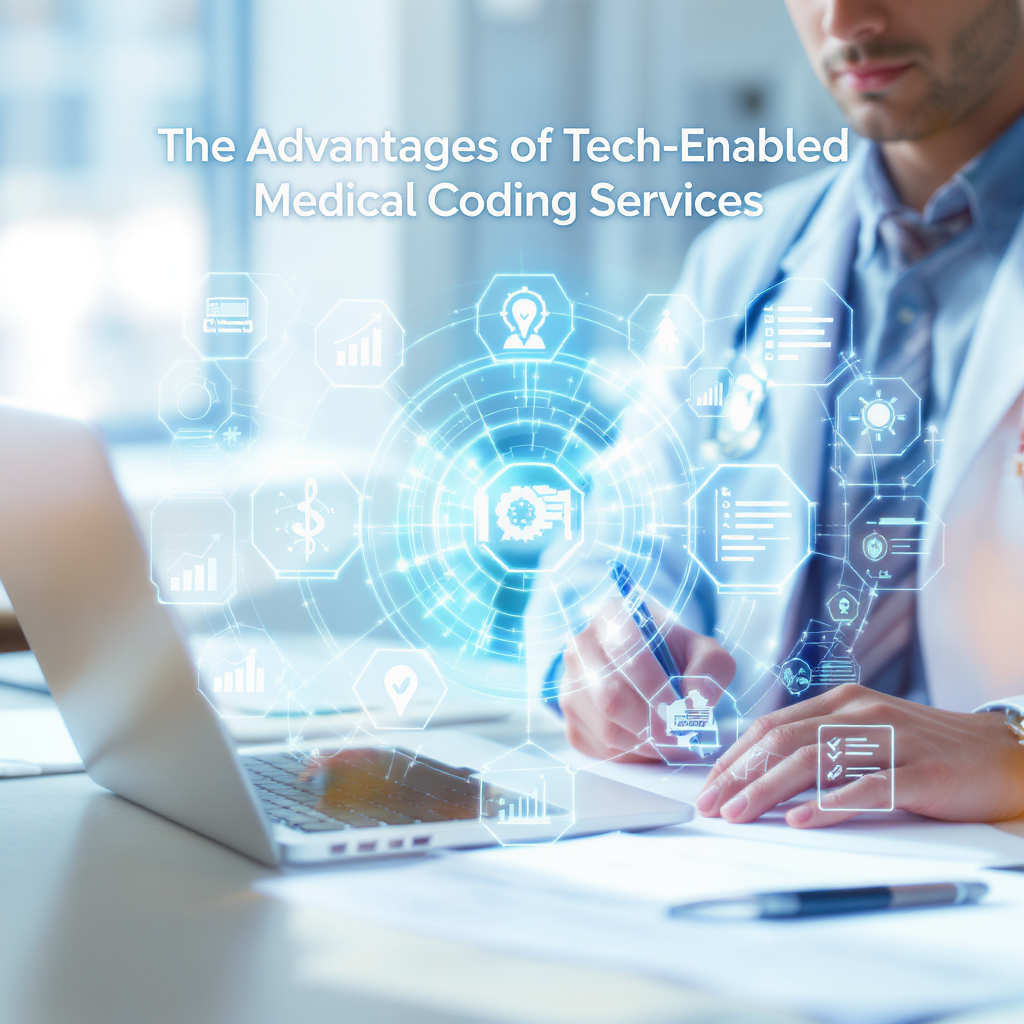Medical Coding: The Future is Now (And It’s Technology-Enabled)
Medical Coding Services
Medical Coding Services
The healthcare landscape is undergoing a dramatic transformation, and at the heart of this evolution lies medical coding. Gone are the days when coders were confined to flipping through thick physical manuals, searching for the perfect code match. Today, technology has revolutionized this critical field, transforming medical coding from a purely manual task into a strategic, digitally-enhanced service that drives healthcare efficiency and accuracy.

Whether you’re a healthcare professional, clinic administrator, or simply someone interested in the future of the industry, understanding the advantages of technology-enabled medical coding services is no longer optional—it’s essential for staying competitive in today’s healthcare ecosystem.
The Digital Revolution in Medical Coding
The medical coding industry has experienced a seismic shift over the past decade. Traditional coding methods that relied heavily on human interpretation and manual processes have given way to sophisticated technological solutions that leverage artificial intelligence, machine learning, and natural language processing. This transformation isn’t just about keeping up with trends; it’s about fundamentally reimagining how healthcare organizations manage their revenue cycles and ensure compliance.
The integration of technology into medical coding represents more than just automation—it’s a strategic enhancement that addresses the growing complexity of healthcare documentation, the increasing volume of patient data, and the ever-evolving regulatory landscape. As healthcare organizations face mounting pressure to improve efficiency while maintaining accuracy, technology-enabled coding services have emerged as a critical solution.
1. Enhanced Accuracy and Reduced Error Rates
Human error is an unavoidable reality in any manual process, and in medical coding, even the smallest mistake can have far-reaching consequences. Incorrect coding can result in claim denials, delayed payments, compliance issues, and costly audits that can significantly impact an organization’s financial stability and reputation.
This is where technology makes its most profound impact. Artificial intelligence-powered coding tools and natural language processing systems can automatically analyze clinical documentation, identifying diagnoses and procedures with remarkable precision. These sophisticated systems are trained on vast datasets of medical records, coding guidelines, and regulatory requirements, enabling them to assign codes with greater accuracy and consistency than traditional manual methods.
Machine Learning Advantages:
- Continuous learning from coding patterns and outcomes
- Real-time updates to reflect the latest coding guidelines
- Pattern recognition that identifies potential inconsistencies
- Automated cross-referencing with multiple code sets (ICD-10, CPT, HCPCS)
Advanced coding platforms can also perform real-time validation checks, comparing assigned codes against clinical documentation to identify potential discrepancies before claims are submitted. This proactive approach significantly reduces the likelihood of claim rejections and the associated costs of rework and resubmission.

2. Dramatically Improved Efficiency and Productivity
Manual coding is inherently time-intensive. Professional coders must carefully review extensive medical records, interpret physician notes, and navigate complex coding guidelines—a process that can create significant bottlenecks in the revenue cycle. With healthcare organizations treating more patients and generating larger volumes of documentation, these inefficiencies compound, leading to delayed billing and cash flow challenges.
Technology transforms this equation entirely. Modern coding solutions can process documentation at unprecedented speeds, analyzing multiple records simultaneously and suggesting appropriate codes based on clinical content. Natural language processing algorithms can extract relevant information from unstructured physician notes, automatically identifying key diagnoses, procedures, and modifiers.
Productivity Enhancements Include:
- Automated code suggestion based on clinical documentation
- Intelligent workflow management and case prioritization
- Automated quality assurance and audit trails
- Seamless integration with electronic health records (EHR) systems
- Real-time collaboration tools for coder-physician communication
This automation doesn’t replace human expertise—it amplifies it. Professional coders can focus their skills on complex cases, unusual scenarios, and quality review processes, while routine coding tasks are handled efficiently by technology. The result is faster turnaround times, accelerated billing cycles, and improved cash flow for healthcare organizations.
3. Revenue Cycle Optimization and Financial Performance
A healthy healthcare revenue cycle depends on accurate, timely coding that ensures proper reimbursement while minimizing claim denials and delays. Technology-enabled medical coding services contribute directly to revenue cycle optimization through multiple pathways.
Financial Impact Areas:
Reduced Claim Denial Rates: By improving coding accuracy and ensuring compliance with payer requirements, technology significantly reduces the percentage of claims that are initially denied, minimizing the costs associated with appeals and resubmissions.
Faster Payment Cycles: Automated coding processes accelerate the time from patient encounter to claim submission, reducing days in accounts receivable and improving cash flow predictability.
Enhanced Reimbursement Capture: Advanced coding systems can identify opportunities for additional revenue capture, such as secondary diagnoses or procedures that might be overlooked in manual coding processes.
Data-Driven Insights: Modern coding platforms generate comprehensive analytics that help administrators identify patterns, trends, and improvement opportunities. These insights can reveal coding productivity metrics, denial patterns, and areas where additional training or process improvements might be beneficial.
Benchmarking and Performance Monitoring: Technology enables real-time monitoring of coding performance against industry benchmarks, helping organizations understand their competitive position and identify areas for improvement.

4. Regulatory Compliance and Risk Mitigation
The healthcare regulatory landscape is complex, dynamic, and increasingly demanding. Staying current with coding guidelines, such as ICD-10-CM/PCS updates, CPT changes, and payer-specific requirements, represents a significant ongoing challenge for healthcare organizations.
Technology-based coding solutions are specifically designed to ensure compliance across multiple dimensions:
Automated Compliance Monitoring:
- Real-time updates to reflect the latest coding guidelines and regulations
- Automated auditing of coding assignments against current standards
- Flagging of potential compliance issues before claim submission
- Integration with official coding updates and guidance
Risk Reduction Strategies:
- Comprehensive audit trails that document coding decisions and rationale
- Automated detection of coding patterns that might trigger regulatory scrutiny
- Built-in safeguards against common compliance violations
- Regular compliance reporting and documentation
Regulatory Adaptability: As healthcare regulations evolve, technology-enabled coding systems can be quickly updated to reflect new requirements, ensuring that organizations remain compliant without significant manual intervention or retraining.
This proactive approach to compliance helps healthcare organizations avoid costly penalties, maintain their reputation, and focus on patient care rather than regulatory concerns.
5. Scalability and Operational Flexibility
Healthcare organizations face fluctuating coding demands due to seasonal variations, changes in patient volume, new service lines, and evolving business needs. Traditional coding models often struggle to accommodate these fluctuations efficiently, requiring organizations to either maintain excess capacity or accept backlogs during peak periods.
Technology provides unprecedented flexibility in scaling coding operations:
Dynamic Resource Allocation:
- Automated load balancing across coding resources
- Cloud-based platforms that can handle volume spikes without infrastructure changes
- Flexible capacity that adjusts to organizational needs
- Rapid deployment of additional coding resources when needed
Geographic Independence: Technology enables coding services to be delivered from anywhere, providing access to specialized expertise regardless of location and enabling 24/7 coding operations across multiple time zones.
Service Customization: Modern coding platforms can be configured to match specific organizational workflows, specialty requirements, and performance metrics, ensuring that technology enhances rather than disrupts existing processes.

6. Advanced Analytics and Business Intelligence
Beyond basic coding functions, technology-enabled services provide powerful analytics capabilities that transform coding data into actionable business intelligence:
Performance Analytics:
- Real-time dashboards showing coding productivity and accuracy metrics
- Trend analysis identifying patterns in coding volume and complexity
- Benchmarking against industry standards and best practices
- Predictive analytics for capacity planning and resource allocation
Clinical Insights:
- Analysis of coding patterns to identify documentation improvement opportunities
- Physician-specific feedback on documentation quality and completeness
- Identification of clinical areas requiring additional training or support
Financial Intelligence:
- Revenue impact analysis of coding decisions
- Identification of high-value coding opportunities
- Cost-benefit analysis of different coding strategies and approaches
7. Integration and Interoperability
Modern healthcare operates on integrated technology platforms, and coding solutions must seamlessly connect with existing systems:
EHR Integration: Direct integration with electronic health records eliminates duplicate data entry and ensures that coding is based on the most current clinical information.
Practice Management Systems: Seamless connection with billing and practice management platforms ensures that coded information flows efficiently through the revenue cycle.
Payer Connectivity: Direct connections with major payers enable real-time eligibility verification and claim status tracking.
The Future Landscape
As we look ahead, the role of technology in medical coding will continue to expand. Emerging technologies such as advanced AI, blockchain for audit trails, and enhanced natural language processing will further transform the industry. Healthcare organizations that embrace these technological advances will be better positioned to thrive in an increasingly complex and competitive environment.

Conclusion: Embracing the Technology-Enabled Future
Medical coding has entered a new era where technology is not just an enhancement—it’s a fundamental requirement for healthcare organizations seeking to improve accuracy, increase efficiency, and optimize their financial performance. The benefits extend far beyond simple automation, encompassing strategic advantages that touch every aspect of healthcare operations.
By adopting technology-enabled coding services, healthcare organizations can:
- Achieve unprecedented levels of coding accuracy and consistency
- Dramatically improve operational efficiency and productivity
- Optimize revenue cycles and financial performance
- Ensure regulatory compliance and mitigate risks
- Scale operations flexibly to meet changing demands
- Gain valuable insights through advanced analytics
The transformation of medical coding through technology represents more than just process improvement—it’s about creating a foundation for sustainable healthcare delivery that prioritizes both operational excellence and patient care. Organizations that embrace this technology-enabled approach will not only streamline their administrative processes but also free their professionals to focus on what truly matters: delivering exceptional patient care and outcomes.
The future of medical coding is here, and it’s powered by technology. The question isn’t whether to adopt these solutions, but how quickly organizations can implement them to gain competitive advantage in the evolving healthcare landscape.



